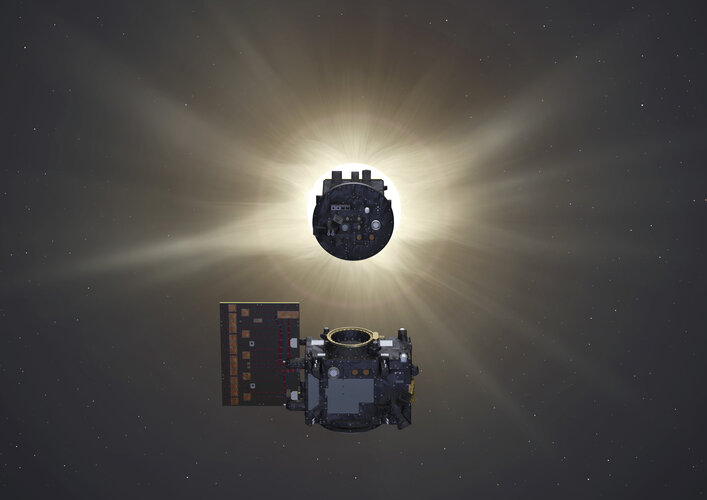
Copernical Team
Proba-3 achieves precise formation flying

For the first time, two spacecraft in orbit were aligned in formation with millimetre precision and maintained their relative position for several hours without any control from the ground.
MTG-S1 and Sentinel-4 take a step closer to space

Fresh from the cleanroom in Bremen, Germany, the second of the Meteosat Third Generation satellites and the first instrument for the Copernicus Sentinel-4 mission have arrived at Cape Canaveral harbour, in the US.
ESA and PLAYMOBIL join forces to inspire the next generation of space explorers

As the European Space Agency (ESA) ramps up Europe’s ambition in space exploration, it is equally committed to sparking curiosity among young minds. What better way to inspire future explorers than with a fully equipped lunar rover – a creation born from our exciting new partnership with PLAYMOBIL?
ESA releases record breaking forest carbon dataset spanning 15 years
 As ESA's new Biomass satellite begins operations after its April 29 launch, the agency has unveiled its most comprehensive satellite-derived forest carbon dataset yet. Covering the years 2007 to 2022, the release marks a major advancement in global forest biomass monitoring.
This extensive dataset, part of ESA's Climate Change Initiative, compiles information from multiple Earth-observing
As ESA's new Biomass satellite begins operations after its April 29 launch, the agency has unveiled its most comprehensive satellite-derived forest carbon dataset yet. Covering the years 2007 to 2022, the release marks a major advancement in global forest biomass monitoring.
This extensive dataset, part of ESA's Climate Change Initiative, compiles information from multiple Earth-observing China Establishes UN-SPIDER Regional Support Office at Wuhan University
 On April 22, United Nations Office for Outer Space Affairs (UNOOSA) Director Aarti Holla-Maini led a delegation to Wuhan University, where a cooperation memorandum was signed with university president Zhang Pingwen, formally establishing the China regional support office of the United Nations Platform for Space-based Information for Disaster Management and Emergency Response (UN-SPIDER).
Z
On April 22, United Nations Office for Outer Space Affairs (UNOOSA) Director Aarti Holla-Maini led a delegation to Wuhan University, where a cooperation memorandum was signed with university president Zhang Pingwen, formally establishing the China regional support office of the United Nations Platform for Space-based Information for Disaster Management and Emergency Response (UN-SPIDER).
Z Orca AI Secures Series B Funding to Drive Autonomous Maritime Solutions
 Orca AI, a pioneering force in maritime technology, has secured $72.5 million in Series B funding to accelerate its efforts in autonomous shipping. The funding round was led by Brighton Park Capital, with participation from existing investors Ankona Capital and Hyperlink Ventures. This new investment will enable Orca AI to enhance its autonomous platform, expand into defense and security applica
Orca AI, a pioneering force in maritime technology, has secured $72.5 million in Series B funding to accelerate its efforts in autonomous shipping. The funding round was led by Brighton Park Capital, with participation from existing investors Ankona Capital and Hyperlink Ventures. This new investment will enable Orca AI to enhance its autonomous platform, expand into defense and security applica Iridium Upgrades 9603 Module with Advanced Secure Messaging for Government Users
 Iridium Communications Inc. (Nasdaq: IRDM) has introduced a specialized U.S. government version of its Iridium 9603 module, now equipped with Enhanced Short Burst Data (ESBD) capabilities. The ESBD system provides low-latency, secure messaging designed to meet the stringent transmission security (TRANSEC) requirements of the U.S. government and approved allies.
The ESBD-enabled 9603 module
Iridium Communications Inc. (Nasdaq: IRDM) has introduced a specialized U.S. government version of its Iridium 9603 module, now equipped with Enhanced Short Burst Data (ESBD) capabilities. The ESBD system provides low-latency, secure messaging designed to meet the stringent transmission security (TRANSEC) requirements of the U.S. government and approved allies.
The ESBD-enabled 9603 module Sunlight Reveals New Insights into Earth's Complex Systems
 When sunlight interacts with Earth, it creates a spectrum of phenomena ranging from the stunning beauty of rainbows to the more subtle but equally intriguing dynamics that shape our planet's atmosphere. Recent advancements in shortwave radiation research are now revealing critical insights into these processes, as highlighted in a new perspective study published in Advances in Atmospheric Scienc
When sunlight interacts with Earth, it creates a spectrum of phenomena ranging from the stunning beauty of rainbows to the more subtle but equally intriguing dynamics that shape our planet's atmosphere. Recent advancements in shortwave radiation research are now revealing critical insights into these processes, as highlighted in a new perspective study published in Advances in Atmospheric Scienc NASA's NICER Maps Debris From Recurring Cosmic Crashes
 For the first time, astronomers have probed the physical environment of repeating X-ray outbursts near monster black holes thanks to data from NASA's NICER (Neutron star Interior Composition Explorer) and other missions.
Scientists have only recently encountered this class of X-ray flares, called QPEs, or quasi-periodic eruptions. A system astronomers have nicknamed Ansky is the eighth QPE
For the first time, astronomers have probed the physical environment of repeating X-ray outbursts near monster black holes thanks to data from NASA's NICER (Neutron star Interior Composition Explorer) and other missions.
Scientists have only recently encountered this class of X-ray flares, called QPEs, or quasi-periodic eruptions. A system astronomers have nicknamed Ansky is the eighth QPE Mars surface patterns resemble Earth, revealing secrets of its past
 Despite its dry, dusty surface and thinner atmosphere, Mars may have more in common with Earth than scientists previously thought.
In a new study, researchers at the University of Rochester-including PhD student JohnPaul Sleiman and Rachel Glade, an assistant professor in the Department of Earth and Environmental Sciences-and their colleagues found that soil features on Mars look remarkabl
Despite its dry, dusty surface and thinner atmosphere, Mars may have more in common with Earth than scientists previously thought.
In a new study, researchers at the University of Rochester-including PhD student JohnPaul Sleiman and Rachel Glade, an assistant professor in the Department of Earth and Environmental Sciences-and their colleagues found that soil features on Mars look remarkabl 